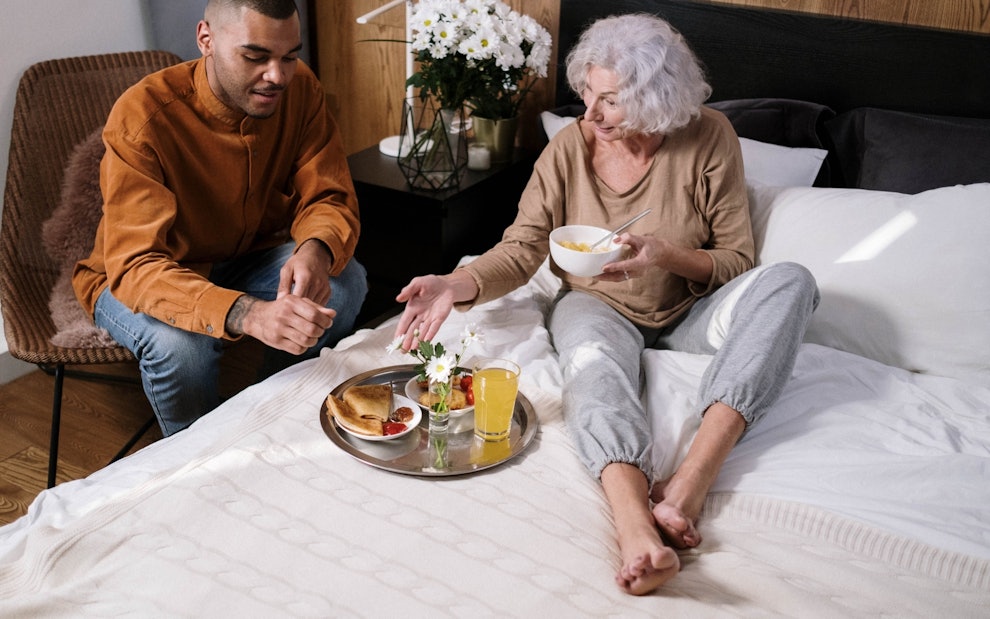Top 6 Breathing Techniques For Anxiety And Reducing Stress
Article at a glance
Experiencing anxiety is normal every once in a while, but constantly feeling anxious could be the sign of an anxiety disorder.
There are many different breathing and breathwork exercises that can help diminish anxiety and trigger a relaxation response, calming you down. This is because breath control can help trigger a relaxation response in the body.

While everyone will have bouts of anxiety from time to time, consistently experiencing feelings of panic, dread, and uneasiness could be the sign of an anxiety disorder. Anxiety is estimated to impact one in five Americans every single year.
Taking a few deep breaths and other types of breathing exercises can help reduce anxiety as well as help other mental health conditions. This article will discuss six breathing techniques for anxiety.
What Is Anxiety?
Anxiety is a feeling of fear, dread, or general uneasiness. While anxiety can be a normal reaction to stress (i.e. before taking a test or making a big decision), constantly feeling anxious could be the sign of an anxiety disorder.
Types Of Anxiety Disorders
There are various types of anxiety disorders including:
Generalized anxiety disorder (GAD): GAD causes individuals to worry about everyday things (i.e. money, health, family, relationships, etc.) in an excessive and disruptive way.
Panic disorder: Panic disorder is defined by panic attacks. These panic attacks come on quickly and suddenly, despite the fact there is no imminent danger. Panic attacks can last several minutes or more.
Phobias: Phobias are fears surrounding things that are not dangerous. Phobias can include spiders, heights, blood, etc.
Anxiety Symptoms
Symptoms of anxiety include:
Anxious thoughts that are difficult to control
Restlessness
Rapid heartbeat
Unexplained aches and pains
Dizziness
Shortness of breath
Avoidance of everyday activities
Anxiety Causes
There is no known cause for anxiety. However, genes, brain biology and chemistry, stress, and environmental factors can play a role in the development of anxiety.
Anxiety Risk Factors
There are various risk factors for developing an anxiety disorder, and these risk factors vary based on the type of disorder. That said, the general risk factors for anxiety include:
Personality traits (i.e. shyness)
Trauma
Family history of anxiety or other mental health issues
Certain physical conditions (i.e. thyroid problems or arrhythmia)

Chest vs. Abdominal Breathing
There are two types of breathing patterns:
Diaphragmatic breathing (abdominal): This breathing is deep and even, engaging the diaphragm and expanding the lungs.
Thoracic breathing (chest): This breathing originates from the chest, in short and rapid breaths.
Shallow Breathing and Anxiety
Anxiety can cause shallow breathing that comes from the chest. These breaths are often quick-paced. Known as thoracic breathing, shallow breathing can disrupt the body’s oxygen and carbon dioxide levels, leading to an increased heart rate, dizziness, muscle tension, and more. This can trigger the body’s stress response and may also contribute to panic and anxiety attacks.
Practicing breath work can help mitigate the effects of anxiety and slow and diminish the body’s stress response when triggered.

Anxiety Breathing Exercises
There are various ways to cope with and reduce anxiety, one method being breathing techniques. Breathing exercises for anxiety can help slow down rapid breathing rates and other distressing symptoms of anxiety.
According to Michigan Health, deep breathing is one of the best ways to lower stress in the body. When you take a deep breath, this sends signals to the brain to calm down and relax. This is because exhaling is linked to the parasympathetic nervous system, which impacts the body’s ability to calm down.
Read on below to learn more about the many breathing exercises for managing stress and anxiety.
Note: It is important to practice breathing techniques when you are calm as well. Even a few minutes a day can help make these exercises more effective in acute moments of stress and anxiety.
Resonance Breathing (Coherent Breathing)
Resonance breathing (also known as coherent breathing) is when you breathe at a speed of five full breaths per minute. To perform resonance breathing, simply inhale at the count of five and then exhale slowly at the count of five. Continue this breathing pattern for a few minutes or until calm.
Diaphragmatic Breathing (Belly Breathing)
Diaphragmatic breathing (also called belly breathing) is a breathing technique that engages your diaphragm, a vital muscle involved in breathing. Diaphragmatic breathing is associated with a number of benefits such as lowering blood pressure and stress levels. Not only that, this type of breathing also is the basis of meditation and other relaxation techniques.
In order to practice diaphragm breathing, adhere to the following:
Sit or lie down on a flat and comfortable surface
Relax your shoulders, moving them away from your ears
Place one hand on your chest and the other hand on your stomach
Without force, breathe in through your nose until you cannot take in any more air
Feel the air moving through your nostrils to your stomach (the chest will remain mostly still)
Purse your lips and exhale slowly through your lips for four seconds, noticing your stomach gently contracting
Repeat the aforementioned a few times for the best results
Box Breathing (Square Breathing)
Box breathing (also called square breathing) is a breathing exercise that involves four steps, each one taking four seconds to complete.
To practice box breathing, follow the steps below:
Sit or stand upright
Slowly exhale through your mouth
Inhale slowly while counting to four, filling your lungs with air (don’t strain)
Hold the breath while counting to four
Exhale slowly while counting to four, releasing the breath
Repeat the aforementioned steps five to 10 more times
4–7‑8 Breathing
4–7‑8 breathing (also referred to as relaxing breath) is a breathing technique. Also known as rhythmic breathing, the 4–7‑8 method requires you to focus on taking long, deep inhales and exhales. Potential benefits include lowering anxiety, getting to sleep faster, managing cravings, and lessening responses to anger.
The 4–7‑8 breathing technique involves following a specific breathing pattern. Before beginning this breathing method, ensure you are in a comfortable and seated position. As well, place the tip of your tongue right behind the top of your teeth.
To practice 4–7‑8 breathing, adhere to the following breathing pattern:
Empty all the air from your lungs before beginning
Breathe in quietly through your nose for four seconds
Hold the breath for seven seconds
Exhale forcefully with your mouth, making a “whoosh” sounds for eight seconds
Repeat this cycle up to four times
Note: There is a possibility that you may feel dizzy or lightheaded after doing this technique the first few times. This is why it is important to make sure you are seated while performing this breathing exercise. This will help prevent falls.
Pursed Lips Breathing
Pursed lip breathing is an exercise that involves pursing the lips. It slows the breath, allowing more air flow inward and outward. It is helpful for engaging in physical activity as well as reducing stress.
To practice pursed lips breathing, follow the steps below:
Relax the neck and shoulders
Breathe in slowly through your nose for two seconds, keeping your mouth shut
Purse your lips as if you’re about to blow on a hot drink
Slowly breathe out through pursed lips for four or more seconds
Alternate Nostril Breathing
Alternate nostril breathing is a simple breathing technique derived from yoga practices.
To practice nostril breathing, follow the steps below:
Sit in a quiet and comfortable position (make sure the room is quiet)
Put on thumb on your right nostril with your right hand (ensure your forefinger and middle finger are out of the way)
With the right nostril covered, close your eyes and exhale completely and slowly through the left nostril
Once you have exhaled entirely, release your right nostril and place your ring finger on the left nostril
Take a deep breath, pulling air in from the right side of your nose (this breath should be slow and continuous)
Once you have inhaled completely, exhale through your right nostril
Take your ring finger off your nose and close the right nostril with your thumb once more, breathing in fully and completely with your left nostril
Repeat the aforementioned steps two or more times
Note: Keep this exercise to 10 minutes or less for maximum benefits.

Other Treatments For Stress and Anxiety Relief
In addition to utilizing breathing strategies to lessen anxiety symptoms, there are other treatment options for anxiety including:
Cognitive behavioral therapy (CBT): Cognitive behavioral therapy is a type of psychotherapy that focuses on how your thoughts impact your behaviors. CBT uses strategies such as exposure therapy to help you learn to cope with your anxiety in a healthy, manageable way.
Medication: Some medications can help with anxiety such as antidepressants, anxiety-anxiety medications, and beta-blockers. Do note that some medications are more beneficial for certain mental health conditions than others. Talk to a healthcare provider about your specific situation.
Support groups: Support groups can be helpful for managing stress and anxiety because these offer social support and guidance for managing.
Exercise: Getting regular physical exercise can help alleviate anxiety and other mental health issues.
5–4‑3–2‑1 Method: This technique is as follows: find five things you can see, four things you can touch, three things you can hear, two things you can smell, and one thing you can taste. Walking your mind through the five senses allows you to focus your mind away from the anxiety and towards grounding yourself in your body and your environment.
When To See A Healthcare Professional
If your anxiety symptoms are interfering with your life in a negative way, it is important to talk about your experience with a mental health professional or other healthcare professional to seek guidance and treatment. You are not alone.
Resources
Find a Therapist in Your Area
Call Centers
Substance Abuse and Mental Health Services Administration’s National Helpline: 1–800-662-HELP (4357)
Suicide Prevention Lifeline: 1–800-273‑8255 (TALK)
Suicide Prevention Lifeline for Hearing Impaired: 1–800-799‑4889
The Samaritans: (877) 870‑4673 (HOPE)
Text Hotlines
Crisis Text Line (Or, on your smartphone, text HOME to 741741)
FAQ
How does breathing help lower anxiety?
Breathing exercises lower anxiety because they help lower the heart rate, breathing pace, and more.
What is the difference between normal anxiety and an anxiety disorder?
While anxiety from time to time is normal, constantly feeling anxious is not. The main difference between normal anxiety and an anxiety disorder is that someone with anxiety as a mental health condition will have recurrent episodes of anxiety that prevent participation and enjoyment of everyday life.
Why does anxiety impact my ability to breathe properly?
Anxiety can make breathing difficult for a number of reasons. For starters, anxiety triggers your body’s fight or flight response. This then releases adrenaline, a hormone that increases your body’s temperature. Adrenaline also causes oxygen to be sent to your muscles, which can cause shortness of breath.
Sources
https://www.onemedical.com/blog/healthy-living/5‑breathing-exercises-stress-and-anxiety-relief/
https://www.psychiatry.org/patients-families/anxiety-disorders
https://newsinhealth.nih.gov/2016/03/understanding-anxiety-disorders
https://www.nccih.nih.gov/health/relaxation-techniques-what-you-need-to-know
https://healthmatch.io/anxiety/how-to-tell-if-shortness-of-breath-is-from-anxiety#other-causes
https://my.clevelandclinic.org/health/articles/9443-pursed-lip-breathing
https://www.webmd.com/balance/what-to-know-about-alternate-nostril-breathing
Become a patient
Experience the Oak Street Health difference, and see what it’s like to be treated by a care team who are experts at caring for older adults.




